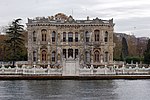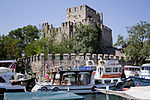Nausikleia
AC with 0 elementsAncient Bithynia geography stubsFormer populated places in TurkeyHistory of Istanbul ProvinceIstanbul Province geography stubs ... and 1 more
Populated places in Bithynia
Nausikleia was a coastal town of ancient Bithynia located on the Bosphorus. Its site is located at mouth of the Küçüksu in Asiatic Turkey.
Excerpt from the Wikipedia article Nausikleia (License: CC BY-SA 3.0, Authors).Nausikleia
Küçüksu Caddesi,
Geographical coordinates (GPS) Address Nearby Places Show on map
Geographical coordinates (GPS)
| Latitude | Longitude |
|---|---|
| N 41.078182 ° | E 29.065455 ° |
Address
İspark
Küçüksu Caddesi
34815
Türkiye
Open on Google Maps






